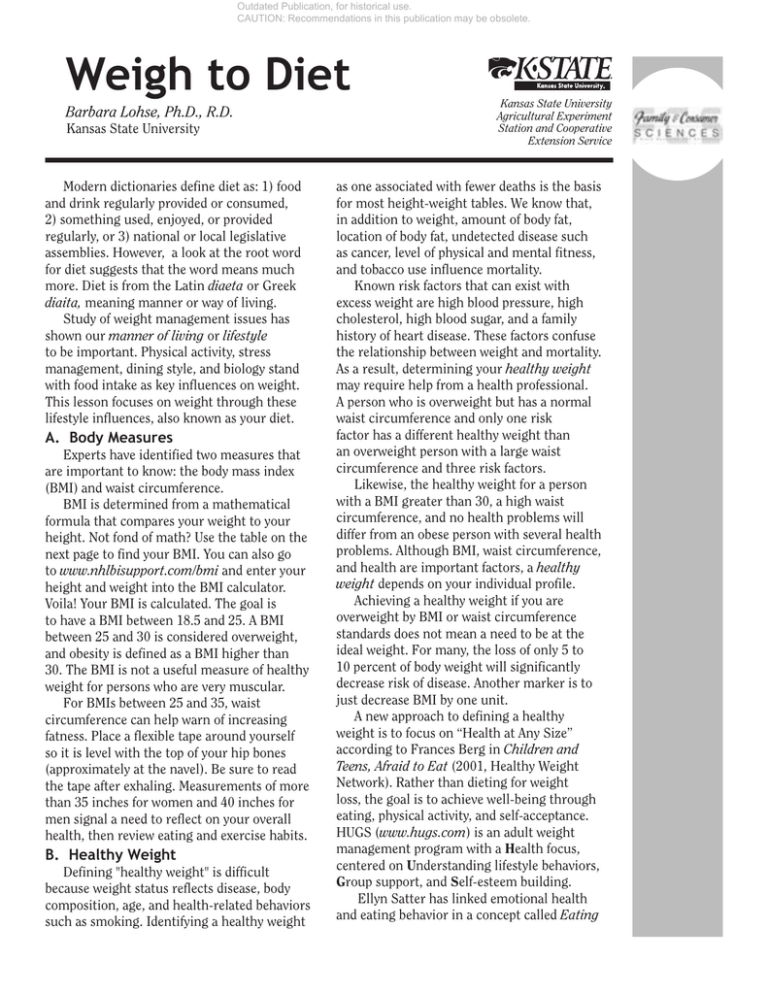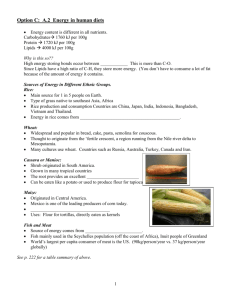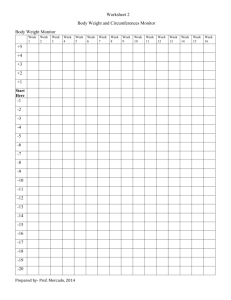
Outdated Publication, for historical use.
CAUTION: Recommendations in this publication may be obsolete.
Weigh to Diet
Barbara Lohse, Ph.D., R.D.
Kansas State University
Modern dictionaries define diet as: 1) food and drink regularly provided or consumed,
2) something used, enjoyed, or provided
regularly, or 3) national or local legislative
assemblies. However, a look at the root word
for diet suggests that the word means much
more. Diet is from the Latin diaeta or Greek
diaita, meaning manner or way of living.
Study of weight management issues has
shown our manner of living or lifestyle to be important. Physical activity, stress
management, dining style, and biology stand
with food intake as key influences on weight.
This lesson focuses on weight through these
lifestyle influences, also known as your diet.
A. Body Measures
Experts have identified two measures that
are important to know: the body mass index
(BMI) and waist circumference. BMI is determined from a mathematical
formula that compares your weight to your
height. Not fond of math? Use the table on the
next page to find your BMI. You can also go
to www.nhlbisupport.com/bmi and enter your
height and weight into the BMI calculator.
Voila! Your BMI is calculated. The goal is
to have a BMI between 18.5 and 25. A BMI
between 25 and 30 is considered overweight,
and obesity is defined as a BMI higher than
30. The BMI is not a useful measure of healthy
weight for persons who are very muscular. For BMIs between 25 and 35, waist
circumference can help warn of increasing
fatness. Place a flexible tape around yourself so it is level with the top of your hip bones
(approximately at the navel). Be sure to read the tape after exhaling. Measurements of more
than 35 inches for women and 40 inches for
men signal a need to reflect on your overall
health, then review eating and exercise habits.
B. Healthy Weight
Defining "healthy weight" is difficult
because weight status reflects disease, body
composition, age, and health-related behaviors
such as smoking. Identifying a healthy weight
Kansas State University
Agricultural Experiment
Station and Cooperative
Extension Service
as one associated with fewer deaths is the basis
for most height-weight tables. We know that,
in addition to weight, amount of body fat,
location of body fat, undetected disease such
as cancer, level of physical and mental fitness,
and tobacco use influence mortality.
Known risk factors that can exist with
excess weight are high blood pressure, high
cholesterol, high blood sugar, and a family
history of heart disease. These factors confuse
the relationship between weight and mortality.
As a result, determining your healthy weight
may require help from a health professional.
A person who is overweight but has a normal
waist circumference and only one risk
factor has a different healthy weight than
an overweight person with a large waist
circumference and three risk factors.
Likewise, the healthy weight for a person
with a BMI greater than 30, a high waist
circumference, and no health problems will
differ from an obese person with several health
problems. Although BMI, waist circumference,
and health are important factors, a healthy
weight depends on your individual profile.
Achieving a healthy weight if you are
overweight by BMI or waist circumference
standards does not mean a need to be at the
ideal weight. For many, the loss of only 5 to 10 percent of body weight will significantly
decrease risk of disease. Another marker is to
just decrease BMI by one unit. A new approach to defining a healthy
weight is to focus on “Health at Any Size”
according to Frances Berg in Children and
Teens, Afraid to Eat (2001, Healthy Weight
Network). Rather than dieting for weight
loss, the goal is to achieve well-being through
eating, physical activity, and self-acceptance.
HUGS (www.hugs.com) is an adult weight
management program with a Health focus,
centered on Understanding lifestyle behaviors,
Group support, and Self-esteem building.
Ellyn Satter has linked emotional health
and eating behavior in a concept called Eating
Outdated Publication, for historical use.
CAUTION: Recommendations in this publication may be obsolete.
BMI
Height 4’10” (58”)91
4’11” (59”)94
5’ (60”) 5’1” (61”) 5’2” (62”) 5’3” (63”) 5’4” (64”) 5’ 5”(65”) 5’6” (66”) 5’7” (67”) 5’ 8”(68”) 5’ 9”(69”) 5’ 10”(70”)
5’ 11”(71”)
6’(72”) 6’ 1”(73”) 6’ 2”(74”) 6’ 3”(75”) 19 20 21 22 23 24 25 26 27 28 29 30 31 32 33 34 35
Weight (in pounds)
96
99
97
100
104
107
110
114
118
121
125
128
132
136
140
144
148
152
100
104
102
106
109
113
116
120
124
127
131
135
139
143
147
151
155
160
105
109
107
111
115
118
122
126
130
134
138
142
146
150
154
159
163
168
110
114
112
116
120
124
128
132
136
140
144
149
153
157
162
166
171
176
115
119
118
122
126
130
134
138
142
146
151
155
160
165
169
174
179
184
119
124
123
127
131
135
140
144
148
153
158
162
167
172
177
182
186
192
124
128
128
132
136
141
145
150
155
159
164
169
174
179
184
189
194
200
129
133
133
137
142
146
151
156
161
166
171
176
181
186
191
197
202
208
134
138
138
143
147
152
157
162
167
172
177
182
188
193
199
204
210
216
138
143
143
148
153
158
163
168
173
178
184
189
195
200
206
212
218
224
143
148
148
153
158
163
169
174
179
185
190
196
202
208
213
219
225
232
148
153
153
158
164
169
174
180
186
191
197
203
209
215
221
227
233
240
Source: Evidence Report of Clinical Guidelines on the Identification, Evaluation, and Treatment of Overweight and Obesity in Adults, 1998.
NIH/National Heart, Lung, and Blood Institute (NHLBI)
Competence, which is more than trying to lose
or maintain weight or trying to get yourself
to eat only healthy foods. It promotes being
positive and comfortable with eating while
making sure to get enough of enjoyable,
nourishing food. (Secrets of Feeding a Healthy
Family, 1999, Kelcy Press)
To you, what is a healthy weight?
Is yours a healthy weight?
Learn more at: www.hsph.harvard.edu/
nutritionsource/weight.html
C. Dieting
To most people “dieting” commonly means
altering food intake to achieve a weight
goal. After reflecting on your health needs
and a weight goal, a change in your dietary
patterns may be in order. Once you plan to
alter your intake, meal plans promising weight
loss, health, and self-esteem will seem to be
everywhere: Eat only raw food! Wine and
chocolate with each meal! Choosing one that
is right for you will take some study. A “No”
answer to the following questions signals a
better plan. Does the plan . . .
•Promise rapid weight loss?
•Offer testimonials and personal stories as
proof?
•Require laboratory tests before you can start?
•Criticize the medical or scientific community?
•Include many supplements and special
ingredients?
•­­Promise you can eat all you want, especially of
certain “good” foods?
•Ignore your food preferences, lifestyle, or
budget?
153
158
158
164
169
175
180
186
192
198
203
209
216
222
228
235
241
248
158
163
163
169
175
180
186
192
198
204
210
216
222
229
235
242
249
256
162
168
168
174
180
186
192
198
204
211
216
223
229
236
242
250
256
264
168
173
174
180
186
191
197
204
210
217
223
230
236
243
250
257
264
272
179
185
191
197
204
210
216
223
230
236
243
250
258
265
272
279
My BMI is
.
My waist measures
Should I be concerned?
in.
Get additional guidance: www.consumer.gov/
weightloss/index.htm
www.eatright.org/Public/NutritionInformation/
92_nfs0200b.cfm
www.ftc.gov/bcp/conline/edcams/fitness/
coninfo.html Even if you can answer “No” to all, select
your plan carefully. For example, a highprotein, low-carbohydrate diet is touted as the
way to lose weight. Does this plan work? Is it
safe? These diets lead to short-term weight
loss because they are low calorie and promote
dehydration. Carbohydrates are stored with
water; a low-carbohydrate diet prompts us to
use these stored carbohydrates, releasing large
amounts of water. Without carbohydrates, we
rely heavily on fat for energy. Using a lot of fat
leads to a condition called ketosis, which can
change electrolytes; leach calcium from bone;
and cause fatigue, nausea, and bad breath.
Metabolizing the high protein intake can harm
kidneys. High-protein diets are high in harmful
saturated fat, low in many vitamins, and – most
important – boring. More studies are needed to
learn about the long-term safety of such plans.
The DASH Eating Plan (Dietary Approaches
to Stop Hypertension), which is much higher
in carbohydrates, has been shown to lower
blood pressure and also may lead to weight
loss and improved cardiac risk factors. The
plan calls for 7 to 8 servings of grains; 4 to 5
vegetables; 4 to 5 fruits; 2 to 3 dairy; 2 meat;
and 4 to 5 nuts, seeds, or beans. Learn more
about the plan, including recipes, from: www.
nhlbi.nih.gov/health/public/
heart/hbp/dash/.
Outdated Publication, for historical use.
CAUTION: Recommendations in this publication may be obsolete.
D. Food Guides
A food guide is a tool to translate nutrition
science into a form that can help people choose
healthy eating patterns. Many healthful eating
patterns have been found for humans, and
controversy about nutrition science concepts
have led to the development of several food
guides. A well-known guide is the USDA Food
Guide Pyramid (shown below). E. Appetite Control
Many other food guides and portion size
help can be found on the Mayo Clinic Web page
www.mayoclinic.com under Health Centers:
Food and Nutrition. Two more food guides are
shown below and at the right.
Willett WC, Stampfer M. Rebuilding the Food Pyramid. Scientific
American 288(1):64-71;2003.
Following a food guide promotes a healthy
lifestyle. Think about what you have eaten
today or what you plan to eat.
• Do you think your intake is healthy
according to one of these food guides?
• Which food guide is right for you
to follow?
With fluctuations in daily activity level, food
intake, and health status, it is amazing that
we maintain relatively stable weight. Weight
stability appears to stem from molecular signals
in the body. Appetite-regulating systems are
designed to protect more against weight loss
than weight gain. Appetite controllers show a
tight connection between brain, gut, and fat
cells. In a specific brain region (the arcuate
nucleus), two nerve cell types keep balance. One type of nerve cell produces Neuropeptide
Y (NPY) and Agouti-Related Peptides (AgRP)
that send messages to increase appetite. The
other nerve cell type, known as POMC/CART
releases alpha-Melanocyte Stimulating
Hormone that decreases appetite. What
activates NPY/AgRP and POMC/CART nerve
cells? Many factors, including Leptin, Insulin,
Ghrelin, and PYY.
Leptin—(from Greek, leptos, meaning
thin), a hormone produced in fat cells, leads to
decreased food intake and appears to protect
against weight loss because shrinking fat stores
mean less leptin is available to lower appetite.
Unfortunately, larger fat stores do not produce
leptin levels high enough to decrease appetite
and weight. Obese persons may not respond to
leptin; current studies focus on problems with
leptin receptors. Leptin production is higher in
women and persons recovering from anorexia
nervosa and is activated by a stress hormone.
Insulin—a hormone produced in specific
cells of the pancreas. Insulin suppresses
appetite by inhibiting NPY, the peptide that
stimulates appetite. Appetite and weight are
better controlled when the brain is insulin
sensitive.
Outdated Publication, for historical use.
CAUTION: Recommendations in this publication may be obsolete.
Ghrelin—a short-term appetite regulator
peptide made in the stomach that stimulates
the release of growth hormone. Ghrelin is a
powerful appetite stimulator, peaking an hour
or two before mealtime. Ghrelin levels are
much lower after gastric bypass surgery.
PYY—another short-term regulator that
decreases appetite, helping to end meals.
Marx J. Science 299:846-849; 2003. Myers M. Eating Disorders
Review 13:1-3;2002. Cummings DE et al. NEJM 346:1623-1630;2002.
Food intake decreases because POMC/
CART nerve cells are stimulated by leptin
and insulin. Along with PYY, these hormones
inhibit NPY/AgRP tracts. Food intake is
increased when ghrelin stimulates NPY &
AgRP nerve cells. Both types of nerve cells
target a satiety center in the brain (the
nucleus tractus solitarius), which promotes a
feeling of fullness or gratification. Messages
from the gut and liver are relayed via intestinal
and spinal nerves to the satiety center.
Cholecystokinin is a peptide produced by the
small intestine in response to food digestion. It decreases appetite by
stimulating a specific nerve to signal the
satiety center that food is being digested.
Draw a chart or diagram on a sheet of
paper to summarize appetite control.
F. Be Active and Stretch!
Finally, a healthy way of living must
include physical activity. In addition to
decreasing risk of chronic disease and
overweight, physical activity reduces stress
and anxiety, and enhances mental health,
strength, and balance. Stretching is an ideal
way to initiate a goal of increased physical
activity.
Physical activity is for every body type.
Check the Active at Any Size Web site for ideas
and safety tips: www.niddk.nih.gov/health/
nutrit/activeatanysize/active.html
Nancy Gyurcsik, Ph.D., Department of
Kinesiology at Kansas State University, offers
some answers to these important questions
about stretching:
•Why should I stretch?
To keep your muscles and joints limber so that
you can do all types of activities that you enjoy
but involve your heart working harder than
when you are at rest.
To lower your risk of falling and getting injured.
•How do I stretch? Move slowly into your stretch.
DO NOT jerk into position or bounce when you
stretch.
HOLD the stretch at the point of mild
discomfort.
•Should I feel pain when I stretch?
Absolutely not – you should only feel mild
discomfort.
•How long should I hold a stretch?
Hold each stretch for 15 seconds. Repeat two
times.
•How many times in a week should I
stretch?
Three to seven times.
•What equipment do I need to stretch?
Not much – only a towel and a chair.
Eager to try some stretching exercises? Get
your doctor’s approval, then select exercises
shown on these Web sites.
www.agingwell.state.ny.us/fitness/stretch/index.htm
www.niehs.nih.gov/odhsb/ergoguid/chapiii.htm
nihseniorhealth.gov/exercise/stretchingexercises/
01.html
After stretching, do you feel better ___
more active ___ healthier ___?
Brand names appearing in this publication are for product identification purposes only.
No endorsement is intended, nor is criticism implied of similar products not mentioned.
Publications from Kansas State University are available on the World Wide Web at: http://www.oznet.ksu.edu
Publications from Kansas State University may be freely reproduced for educational purposes. All other rights reserved.
In either case, credit Barbara Lohse, Ph.D. R.D., Weigh to Diet, August 2003.
Kansas State University Agricultural Experiment Station and Cooperative Extension Service , Manhattan, Kansas
MF-2595
August 2003
It is the policy of Kansas State University Agricultural Experiment Station and Cooperative Extension Service that all persons shall have equal opportunity and access to its
educational programs, services, activities, and materials without regard to race, color, religion, national origin, sex, age, or disability. Kansas State University is an equal opportunity
organization. These materials may be available in alternative formats.
Issued in furtherance of Cooperative Extension Work, Acts of May 8 and June 30, 1914, as amended. Kansas State University, County Extension Councils, Extension Districts, and
United States Department of Agriculture Cooperating, Marc A. Johnson, Director.




